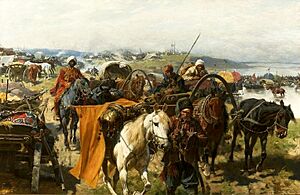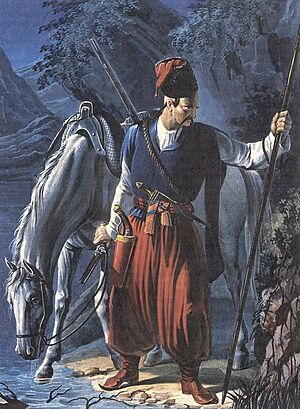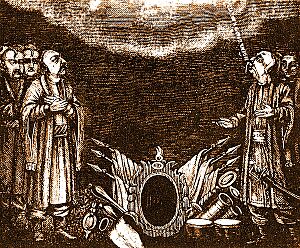Zaporozhian Sich facts for kids
Quick facts for kids
Free lands of the Zaporozhian Host the Lower
Вольностi Вiйська Запорозького Низового
|
|||||||||||
|---|---|---|---|---|---|---|---|---|---|---|---|
| 1552–1775 | |||||||||||
|
Flag
|
|||||||||||

Historical map of the Ukrainian Cossack Hetmanate (dark green) and of the territory of the Zaporozhian Cossacks (purple) under the rule of the Russian Empire (1751)
|
|||||||||||
| Status | Vassal state of Poland–Lithuania (1583–1657) |
||||||||||
| Demonym(s) | Zaporozhian Cossacks | ||||||||||
| Government | Cossack Republic | ||||||||||
| Historical era | Early modern period | ||||||||||
|
• Established
|
1552 | ||||||||||
|
• Disestablished
|
1775 | ||||||||||
|
|||||||||||
| Today part of | Ukraine | ||||||||||
The Zaporozhian Sich (pronounced Za-po-ROZH-yan Seech) was a special place where Cossacks lived and governed themselves. It was like a mini-state that existed from the 1500s to the late 1700s. This area was located around the lower Dnieper river in what is now Ukraine.
The Zaporozhian Sich was a very independent place. However, at different times, it was under the control of bigger powers. These included the Polish–Lithuanian Commonwealth, the Ottoman Empire, and the Russian Empire.
In 1775, a powerful Russian empress named Catherine the Great decided to end the Sich. She took its land and made it part of a Russian province called Novorossiya. The term Zaporozhian Sich can also mean the entire group of Zaporozhian Cossacks and how they were organized.
Contents
What's in a Name?
The name Zaporizhia tells us where the Cossacks lived. It means 'beyond the rapids' (za porohamy) of the Dnieper River. The Dnieper River had many fast-flowing parts called rapids. These rapids were important for trade routes.
The word sich comes from an old East Slavic word meaning 'to chop' or 'cut'. This might refer to the sharp wooden fences or stockades that protected Cossack settlements.
The main area of Zaporizhia is now covered by the Kakhovka Reservoir in southeastern Ukraine. This region was also known as the Wild Fields because it was mostly open, unsettled land.
A Look at History
The Zaporozhian Sich began as a way for people to defend themselves. They needed protection from frequent attacks by Crimean Tatars. These raids captured and enslaved many people from Ukraine, Belarus, and Poland. The Cossacks were a brave self-defense force. They built strong, fortified camps called sichi to stop the Tatars. These camps later joined together to form the main Zaporozhian Sich.
The first Zaporozhian Sich was built in 1552 by Prince Dmytro Vyshnevetsky. He built a fortress on Small (Mala) Khortytsia island. Tatar forces destroyed this fortress in 1558. Other sichi were built and destroyed over time. For example, the Tomakivka Sich was built on an island that is now underwater. It was destroyed in 1593. A third sich on Bazavluk island lasted until 1638. It was destroyed by Polish forces during a Cossack uprising. These early settlements were already quite organized, like small states.
Fighting for Freedom
The Zaporozhian Cossacks were part of the Polish Crown's Kiev Voivodeship from 1583 to 1657. But they didn't like being ruled by Poland. One big reason was religion: Cossacks were Orthodox Christians, while most Poles were Catholics.
So, the Cossacks fought for their independence for a long time. They fought against the Polish state, the Ottoman Empire, the Crimean Khanate, and the Russian Empire. The Sich became the heart of Cossack life. It was governed by the Sich Rada (a council) and led by a Kosh Ataman.
In 1648, Bohdan Khmelnytsky started a big uprising against Poland. This led to the creation of the Cossack Hetmanate (1648–1764). After a treaty in 1654, the Cossack Host split. The Hetmanate had its capital at Chyhyryn. Zaporozhia, centered on the Sich, remained more independent. The Sich moved several times during this period.
During the rule of Peter the Great of Russia, Cossacks were forced to work. They built canals and forts in northern Russia. Many thousands were sent each year. The hard work caused many deaths, and only about 40% of Cossacks returned home.
After a major battle in 1709, the Chortomlyk Sich was destroyed. Another Sich was built, but it was also destroyed by the Russian government in 1711. The Cossacks then fled to the Crimean Khanate. They built the Oleshky Sich there in 1711.
In 1734, the Cossacks were allowed to return to the Russian Empire. They built a "New Sich" near their old one. By 1768, about 52,000 people lived in the steppe region.
Russia became worried about the Sich's independence. In 1764, Russia ended the Hetmanate. Cossack officers became part of the Russian nobility. But ordinary Cossacks were often treated like peasants. After a war with the Ottoman Empire, Russia no longer needed the Cossacks to protect its borders.
The End of the Sich

In May 1775, Russian General Peter Tekeli was ordered to destroy the Zaporozhian Sich. This order came from Catherine the Great. On June 5, 1775, Tekeli surrounded the Sich with his army. The Cossacks decided to surrender.
The Sich was officially ended on August 3, 1775. Catherine's order said the Sich was "Liquidated" and its land added to Novorossiya. The Sich fortress was completely destroyed.
Some Cossack officers, called starshyna, became Russian nobles. They received large amounts of land. But some Cossacks tried to escape. About 5,000 Zaporozhians managed to flee. Some went to the Danube Delta and formed a new Danube Sich. Others went to Hungary.
The leader of the Zaporozhian Host, Petro Kalnyshevsky, was arrested. He was sent away to the Solovetsky Islands. He lived there until he was 112 years old. Other high-ranking officers were also punished. Most ordinary Cossacks became peasants or even serfs.
Later, in 1780, General Grigory Potemkin tried to bring some Cossacks back. They helped Russia fight the Turks in a war from 1787 to 1792. He gathered almost 12,000 Cossacks. They were called the Black Sea Cossacks. After the war, Russia moved them to the Kuban River area. In 1860, they became known as the Kuban Cossacks.
The end of the Zaporozhian Sich was a very important event. People remembered it for a long time in their stories and songs.
How the Sich Was Organized
The Zaporozhian Host was led by the Sich Rada. This was a council where all members could vote. They elected a Kosh Otaman to be their main leader. The Otaman had helpers like a head secretary, a head judge, and a head archivist. During battles, the Otaman had full power. He decided with the Rada whether to support other leaders or states.
Some people called the Zaporozhian Sich a "Cossack republic." This is because the highest power belonged to the assembly of all its members. Their leaders were chosen by election. The Cossacks lived in groups called "kurins," each with hundreds of Cossacks.
The Cossacks had strict rules. Their military court punished violence and stealing among themselves. They also punished bringing women into the Sich and drinking alcohol during conflicts. The Sich also had Orthodox churches and schools for children.
Many different people lived in the Sich. They came from Ukraine, Moldova, Tatar lands, Poland, Lithuania, Russia, and other places. There were nobles, merchants, farmers, and even runaway slaves. Some people who weren't accepted into the main Cossack group formed their own gangs. But after the Khmelnytsky Uprising, most of these groups joined the main Cossack society.
Cossack Army and Fighting
The Cossacks were skilled warriors. They built many fast, light ships. They used these ships to attack rich towns on the Black Sea coast of the Ottoman Empire. Sometimes, they even reached cities like Constantinople and Trabzon.
Where the Zaporozhian Siches Were Located
- Khortytsia Sich (1556–1557) on Khortytsia Island.
- Tomakivka Sich (1564–1593) near today's Marhanets.
- Bazavluk Sich (1593–1638) near today's village of Kapulivka.
- Mykytyn Sich (1639–1652) in Nikopol.
- Chortomlyk Sich (1652–1709) near today's village of Kapulivka.
- Kamyanka Sich (1709–1711) near Respublikanets village.
- Oleshky Sich (1711–1734) on the eastern edge of Oleshky city.
- Nova Pidpilnenska Sich (1734–1775) near Pokrovske village.
- Danubian Sich (1775–1828) in the Danube Delta.
See also







